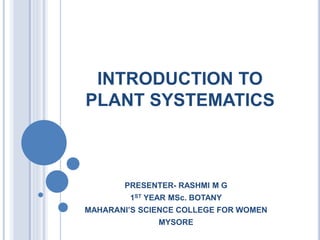
INTRODUCTION TO PLANT SYSTEMATICS.pptx
- 1. INTRODUCTION TO PLANT SYSTEMATICS PRESENTER- RASHMI M G 1ST YEAR MSc. BOTANY MAHARANI’S SCIENCE COLLEGE FOR WOMEN MYSORE
- 2. INTRODUCTION TAXONOMY The science of the classification of organisms according to their resemblances and differences SYSTEMATICS Radford (1986) defined systematics as “The study of phenotypic, genetic and phylogenetic relationship among taxa” and mentioned that the science of systematics posses following essential qualities “Taxonomy is the science of classification and relationships of organisms Systematics is the part of classification that involves the arrangement of organisms into related groups”
- 3. OBJECTIVES,GOALS AND AIMS OF PLANT SYSTEMATICS OBJECTIVES 1. To prepare a scheme of classification that provides phenetic, natural or phylogenetic relationships among plants 2. To establish a suitable method for identification, nomenclature and description of plant taxa 3. To provide an inventory of plant taxa that suits local, regional and continental needs 4. To create an understanding of the evolutionary processes 5. To train the students of plant sciences in regard to the diversity of organisms and their relationship with other biological branches
- 4. OBJECTIVES,GOALS AND AIMS OF PLANT SYSTEMATICS GOALS 1. To acquire the fundamental values of plant systematics 2. To know about the basic concepts and principles of plant systematics 3. To be aware of the importance of taxonomic relationships in plant systematics 4. To develop the knowledge of applicability of plant systematics studies
- 5. OBJECTIVES,GOALS AND AIMS OF PLANT SYSTEMATICS AIMS 1. To know how to collect specimens 2. To know how to prepare specimens for future preservation 3. To know how a manual should be used 4. To know how to use identification keys 5. To recognize divisions, classes, orders, families, genera and species 6. To know how the plants are described 7. To know how the diversity in species may be related with the regional habitat diversity 8. To become familiar with the basic taxonomic principles, and with at least one system of plant classification
- 7. BASIC COMPONENTS OF TAXONOMY Classification, identification, description and nomenclature are the four basic components of taxonomy Classification- is the arrangement of botanical groups with definite circumscriptions by position and rank according to artificial criteria, phenetic similarities, or phylogenetic relationships Identification –is the determination of similarities or dissimilarities between the two elements under identification we make a direct comparison of the characteristic features of a specimen with those present in the already existing keys for identification Description- is the orderly recording of maximum possible characters of a taxon, individual plant, plant part, or object Nomenclature- is a simple system under which the individual taxonomic groups of plants are scientifically named
- 8. CLASSIFICATION Andrew Sugden (1984) defined the word “classification” on Longman Illustrated Dictionary of Botany as “ the naming of species and their grouping into families, orders, divisions etc” Radford(1986) stated that “ classification is the arrangement of groups of plants with particular circumscriptions by rank and position according to artificial criteria , phenetic similarities or phylogenetic relationships”
- 9. RANK OF PLANT CLASSIFICATION Species, genus, family, order, class and division are the 6 main ranks of plant classification in an ascending order. Each rank has its subcategories , i.e. towards the higher ranks, sub form, form, sub varieties, varieties and subspecies are the subcategories of species, subsection, section and sub genus re the subcategories of genus; subtribe, tribe and subfamily are the subcategories of family ;suborder is the subcategory of order; subclass is the subcategory of class; and subdivision is the subcategory of division
- 11. RANKS OF TAXA ENDING OF RANKS EXAMPLES Division subdivision -Phyta -Phytina Pterophyta Pterophtina Class subclass -Opsida -Opsidae Pteropsida Pteropsidae Order suborder -Ales -Ineae Rosales, asterales, rosineae Family subfamily tribe subtribe -aceae -oideae -eae -Ineae Rosaceae,asteraceae Rosoideae Roseae Rosinae Genus subgenus section Sub section series subseries Us, a, um, on, es etc. Rosa, pinus Species subspecies
- 12. TYPES OF SYSTEMS OF CLASSIFICATION Phylogenetic system Mechanical system Artificial system Natural system
- 13. TYPES OF SYSTEMS OF CLASSIFICATION The past taxonomic literature described 3 basic categories of systems of classification i.e. artificial systems, natural systems and phylogenetic systems. But Radford(1986) has described following four types of the systems of classification Artificial classification- these system use the habit and importance to man as the taxonomic characters Some advocates of artificial systems of classifications were Theophrastus(370-285 B.C.), Brunfels(1464-1534)
- 14. • Engler • Prantl • Bessey • Takhtajan • Cronquist • Caesalpino • Linnaeus • Theophrastus • Brunfels • A.L de Jussieu • A.P de Candolle • Bentham and Hooker Natural system Artificial system Phylogenetic system Mechanical system
- 15. BENTHAM AND HOOKER THEOPHRASTUS CAROLUS LINNAEUS BESSY
- 16. TYPES OF SYSTEMS OF CLASSIFICATION Mechanical classification- these systems used one or a few selected taxonomic characterized to group taxa. Some mechanical classifications were given by Caesalpino(1519-1603) and Linnaeus (1707-1778) Natural classification- these system of classifications used as many taxonomic characters as possible to group taxa. some of natural systems of classification were given by A.L. de Jussieu (1748-1836) , A.P. de Candolle (1778-1841) , Bentham (1800-1884) and Hooker( 1817-1911)
- 17. TYPES OF SYSTEMS OF CLASSIFICATION Phylogenetic classification- these system of classification used as many taxonomic characters as possible in addition to the phylogenetic (evolutionary) interpretations Some of the phylogenetic systems of classification were proposed by Engler (1844-1930) and Prantl (1849-1893), Bessey (1845-1915) Hutchinson (1884-1972), Takhtajan (1980), Cronquist (1981)
- 18. CONCLUSION The study of diversity of plants and their identification, naming, classification, and evolution is known to be a PLANT SYSTEMATICS The study of classification is known to be TAXONOMY The systematics is based on the idea that because of great diversity in the biological world there exist some ‘discontinuos units’ that can be identified,classified,described and named on the basis of evolution. It is the unending field for understanding taxonomic and evolutionary processes, principles and concepts. REFERENCE PLANT TAXONOMY BY O P SHARMA -2ND EDITION